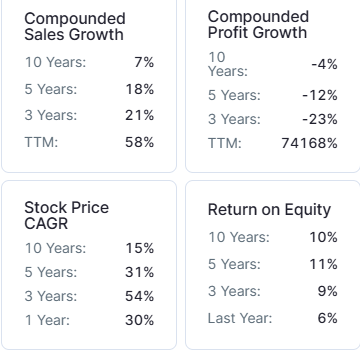Multi Commodity Exchange of India Ltd. (MCX) was listed on the NSE and BSE on March 9, 2012. In the last 5 years, its stock has given a massive return of around 440% to its investors. Will MCX continue to provide such great returns in the future as well? Let’s explore MCX’s future growth potential and the MCX’s share price target 2025 to 2050 in this article
About MCX

MCX (Multi Commodity Exchange of India Ltd) is a platform where people can buy and sell commodities like gold, silver, oil, and farm products for future prices. It was started in 2003 and is one of India’s biggest markets for trading commodities. MCX helps businesses and traders manage price changes so they don’t face big losses. The government body SEBI monitors it to ensure fairness and safety.
MCX Business Model
- Fee on Every Trade: MCX takes a small fee whenever someone buys or sells commodities on its platform.
- Yearly Fees from Brokers: Brokers and traders pay MCX a fixed amount every year to use its services.
- Selling Market Data: MCX sells live price updates and past market data to traders and businesses.
- Earning from Deposits: Traders and brokers keep money with MCX as a security deposit, and MCX earns interest on it.
- Providing Trading Software: MCX sells and maintains trading software for brokers and traders.
MCX Fundamental Analysis
| Stock Name | MCX Ltd. |
|---|---|
| NSE Symbol | MCX |
| Market Cap | ₹ 28919 Cr. |
| 52W High | ₹ 7,049 |
| 52W Low | ₹ 2,917 |
| Stock P/E | 69.7 |
| Book Value | ₹ 378 |
| Dividend Yield | 0.13 % |
| ROCE | 31.8 % |
| ROE | 23.8 % |
| Face Value | ₹ 10.0 |
| Industry PE | 50.0 |
| Price to book value | 15.0 |
| Debt to equity | 0.00 |
| PEG Ratio | 3.17 |
| Quick ratio | 2.33 |

| Shareholders | March 2023 | March 2024 | March 2025 |
|---|---|---|---|
| FIIs | 26.95% | 23.22% | 21.80% |
| DIIs | 52.70% | 56.86% | 58.10% |
| Public | 20.16% | 19.73% | 19.90% |
| Others | 0.19% | 0.19% | 0.19% |
| No. of Shareholders | 1,88,868 | 1,76,305 | 2,43,456 |
Key Factors Driving MCX Future Growth
- Market Leadership: MCX holds a dominant position in India’s commodity futures market with a market share of 95.9% in FY24. It commands a 100% share in precious metals and stones, 99.61% in energy, and 99.80% in base metals.
- Product Innovation and Expansion: The MCX has proactively introduced new products and indices, such as futures contracts on specific agricultural commodities and complex derivatives. These innovations target a broader range of market participants and are expected to increase trading volumes.
- Technological Advancements: The exchange’s recent transition to a new trading platform developed by Tata Consultancy Services (TCS) is expected to cut annual software costs by up to 80%. This cost-cutting measure boosts profits and operational efficiency.
- Regulatory Support and Market Expansion: Favorable regulations from the Securities and Exchange Board of India (SEBI), such as allowing mutual funds and foreign portfolio investors (FPIs) to trade in commodity derivatives, have broadened the investor base.
- Strategic Partnerships and Collaborations: The MCX has formed partnerships with fintech companies to improve trading experiences and customer engagement. These collaborations are expected to bring more participants into the commodity markets.
- Financial Projections: Analysts anticipate a compound annual growth rate (CAGR) of approximately 15% in MCX’s revenue over the next five years, driven by increased trading volumes and new product offerings.
Pros of MCX
- Debt-Free Company: MCX is a debt-free company with a debt-to-equity ratio of 0, which shows its financial stability.
- Increase in FIIs Holding: Foreign Institutional Investors (FIIs) have increased their holding to 23.13% in December 2024 from 22.07% in September 2024, which indicates growing confidence in the MCX future potential by the FIIs.
- Strong Sales Growth: MCX sales have grown at a CAGR of 21% over the last 3 years.
- Consistent Revenue Growth: MCX sales have grown at 45% CAGR over the last three years.
- Consistent Profit Growth: MCX profits have grown at 45% CAGR over the last three years.
- Debt Free Company: MCX is almost debt free company with a debt to equity ratio of 0.00, which shows its financial stability.
- Increase in DIIs Holding: Domestic Institutional Investors (DIIs) have increased their holding to 58.10% in March 2025 from 56.27% in December 2024, which indicates growing confidence in the MCX future potential by the DIIs.
Cons of MCX
- Declining Profits: MCX’s profits have decreased at a CAGR of 23% over the last three years.
- Low Return on Equity (ROE): MCX’s 5-year average ROE is 10.8%, which indicates inefficient use of shareholder funds to generate profits.
- Low Return on Capital Employed (ROCE): Over the last five years, MCX’s average ROCE is 13.1%, which shows that MCX is not using its capital efficiently to generate profits.
- High Price to Book Value: MCX is trading at a Price-to-Book Value (P/B) ratio of 15.1, which indicates that its stock is significantly overvalued compared to its book value.
- Overvaluation Concern: MCX stock is trading at a PE ratio of 69.7 and a (P/B) ratio of 15.0, which shows that its stock is significantly overvalued compared to its earnings and assets.
- Decrease in FIIs Holding: Foreign Institutional Investors (FIIs) have reduced their holding to 21.80% in March 2025 from 23.13% in December 2024, indicating a decline in FII’s confidence in the company’s future growth prospects.
MCX Ltd Balance Sheet
| Particulars | March 2023 | March 2024 | March 2025 |
|---|---|---|---|
| Equity Capital | 51 | 51 | 51 |
| Reserves | 1,545 | 1,499 | 1,876 |
| Borrowings | 2 | 2 | 1 |
| Other Liabilities | 260 | 259 | 367 |
| Total Liabilities | 1,857 | 1,811 | 2,296 |
| Fixed Assets | 145 | 373 | 417 |
| CWIP | 168 | 16 | 6 |
| Investments | 1,216 | 1,137 | 1,629 |
| Other Assets | 328 | 286 | 243 |
| Total Assets | 1,857 | 1,811 | 2,296 |
By the end of 2025, the MCX share price is expected to be around ₹8000 in normal conditions. In a bear market, it might be ₹7100, and in a bull market, it may cross its 52-week high of ₹8800.
| MCX Share Price Target 2025 | Rupees (₹) |
|---|---|
| 1st Target | 7100 |
| 2nd Target | 8000 |
| 3rd Target | 8800 |
In 2026, the MCX share price is expected to be around ₹9050 in a normal situation. In a bear market, it might be ₹8500, and in a bull market, it may cross ₹11,500.
| Tata Steel Share Price Target 2026 | Rupees (₹) |
|---|---|
| 1st Target | 8500 |
| 2nd Target | 9050 |
| 3rd Target | 11,500 |
According to our analysis, the MCX share price is expected to be around ₹11,000 in 2027. In a bear market, it might be ₹10,000, and in a bull market, it may cross ₹14,800.
| MCX Share Price Target 2027 | Rupees (₹) |
|---|---|
| 1st Target | 10,000 |
| 2nd Target | 11,000 |
| 3rd Target | 14,800 |
According to our analysis, the MCX share price may trade near ₹13,000 by 2028; bearish conditions could pull it down to ₹10,500, while a strong bull run might lift it to ₹19,500.
| MCX Share Price Target 2028 | Rupees (₹) |
|---|---|
| 1st Target | 10,500 |
| 2nd Target | 13,000 |
| 3rd Target | 19,500 |
In a normal situation, the MCX share price is projected to be approximately ₹15,300 in 2029. In a bear market, the value may be as low as ₹14,700, while in a bull market, it may rise to ₹25,000.
| MCX Share Price Target 2029 | Rupees (₹) |
|---|---|
| 1st Target | 14,700 |
| 2nd Target | 15,300 |
| 3rd Target | 25,000 |
In a normal situation, the MCX share price is projected to be approximately ₹19,500 in 2030. In a bear market, the value may be as low as ₹17,600, while in a bull market, it may rise to ₹32,600.
| MCX Share Price Target 2030 | Rupees (₹) |
|---|---|
| 1st Target | 17,600 |
| 2nd Target | 19,500 |
| 3rd Target | 32,600 |
By 2035, the MCX share price is projected to be around ₹40,000 under normal conditions. In adverse markets, the price could fall to ₹35,000, while favorable conditions might push it up to ₹97,900.
| MCX Share Price Target 2035 | Rupees (₹) |
|---|---|
| 1st Target | 35,000 |
| 2nd Target | 40,000 |
| 3rd Target | 97,900 |
Under normal conditions, the MCX share price might hit ₹85,000 by 2040. A bearish trend could lower it to ₹70,500, whereas a bullish surge could raise it to ₹2,93,600.
| MCX Share Price Target 2040 | Rupees (₹) |
|---|---|
| 1st Target | 70,500 |
| 2nd Target | 85,000 |
| 3rd Target | 2,93,600 |
In 2050, the MCX share price is expected to be around ₹5,50,000 in a normal situation. In a bear market, it might be ₹2,82,500, and in a bull market, it may go up to ₹17,62,000.
| MCX Share Price Target 2050 | Rupees (₹) |
|---|---|
| 1st Target | 2,82,500 |
| 2nd Target | 5,50,000 |
| 3rd Target | 17,62,000 |
| Years | Target Price |
|---|---|
| MCX Share Price Target 2025 | ₹7100 to ₹8800 |
| MCX Share Price Target 2026 | ₹8500 to ₹11,500 |
| MCX Share Price Target 2027 | ₹10,000 to ₹14,800 |
| MCX Share Price Target 2028 | ₹10,500 to ₹19,500 |
| MCX Share Price Target 2029 | ₹14,700 to ₹25,000 |
| MCX Share Price Target 2030 | ₹17,600 to ₹32,600 |
| MCX Share Price Target 2035 | ₹35,000 to ₹97,900 |
| MCX Share Price Target 2040 | ₹70,500 to ₹2,93,600 |
| MCX Share Price Target 2050 | ₹2,82,500 to ₹17,62,000 |
Conclusion
MCX has established itself as a leading commodity exchange in India, benefiting from strong market leadership, technological advancements, and regulatory support. While the company is debt-free and has seen strong sales growth, challenges such as declining profits, low return ratios, and high valuation remain concerns. With strategic initiatives such as a new trading platform and product innovation, MCX aims for long-term growth. If the company continues to expand its market presence and improve profitability, investors could see significant returns in the coming years. For latest updates, you can visit MCX official website.
Disclaimer
This article is for educational purposes only. It is not a stock recommendation and should not be treated as such. Please ask your financial advisor before making any investment decision.

